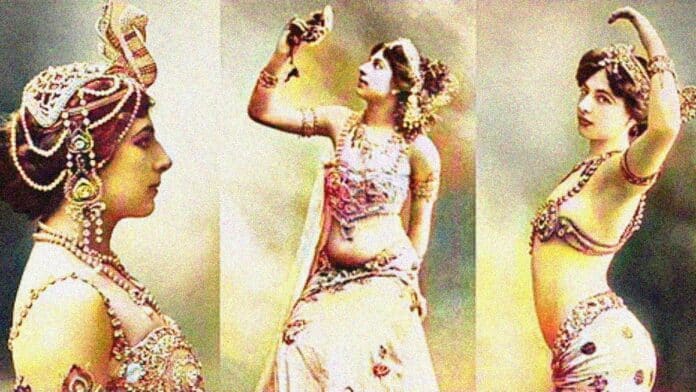Mata Hari, a name that conjures images of mystery, intrigue, and seduction, was one of the most enigmatic figures of the early 20th century. Born Margaretha Geertruida Zelle in the Netherlands, she rose to prominence as a dancer and exotic performer before becoming embroiled in espionage during World War I. This article delves into the life of Mata Hari, exploring her early years, her seductive persona, her espionage activities, and the controversies surrounding her trial and execution. Drawing from historical records, let us uncover the fascinating story of Mata Hari, the femme fatale of the espionage world.
Contents
The Early Years: From Margaretha to Mata Hari
Margaretha Geertruida Zelle, later known as Mata Hari, was born in Leeuwarden, Netherlands, in 1876. Her childhood was marked by tragedy, as her parents divorced when she was a young girl. Despite the challenges, Margaretha developed a love for the arts, particularly dance. At the age of 18, she married a Dutch naval officer and moved to the Dutch East Indies (present-day Indonesia).
It was during her time in the Dutch East Indies that Margaretha began to embrace exoticism and transform into Mata Hari. Inspired by the vibrant local culture, she immersed herself in the traditions, clothing, and dances of the region. This fusion of influences would later shape her captivating persona as an exotic performer.
The Seductive Persona: Rise to Fame
Following a turbulent marriage, Margaretha returned to Europe and settled in Paris. The city’s bohemian scene provided her with the perfect platform to showcase her talents and reinvent herself. Embracing the world of dance and performance, she captivated audiences with her sensuality and exotic allure.
Rechristened as Mata Hari, she embraced the persona of a Javanese princess, adorning herself with ornate costumes and jewelry. Her performances combined elements of dance, theater, and eroticism, which intrigued and enthralled spectators. Mata Hari became a symbol of liberation and seduction in a rapidly changing society.
Did sex become her downfall?
Sex and Mata Hari’s reputation as a seductress played a significant role in her downfall. Throughout her life, Mata Hari used her charm, beauty, and sexuality to captivate influential men and gain access to privileged circles. However, these very attributes eventually became weapons used against her.
Firstly, Mata Hari’s provocative performances as an exotic dancer, characterized by sensuality and eroticism, garnered both admiration and controversy. While her performances brought her fame and notoriety, they also contributed to the perception of her as a sexually liberated woman who defied societal norms. This image of a woman who embraced her sexuality was both alluring and threatening to the conservative elements of society.
During World War I, as tensions escalated and suspicion grew, Mata Hari’s association with powerful men and her reputation as a seductress made her a target for scrutiny. Her relationships with military officers and influential figures, including high-ranking officials from different nations, raised suspicions about her potential involvement in espionage. Her ability to charm and manipulate these men fueled speculation that she used sex as a tool to extract information and gain favor.
Furthermore, the prevailing stereotypes and prejudices of the time portrayed women as inherently deceitful and manipulative, using their sexuality to betray and undermine. Mata Hari’s image as a seductress fit into these preconceived notions, making her an easy target for accusations and scapegoating. The convergence of her provocative performances, personal relationships, and the wartime climate created a narrative that painted her as a dangerous spy using sex as a weapon.
The sensationalized media coverage and public perception further exacerbated the role of sex in Mata Hari’s downfall. Newspapers and propaganda machinery capitalized on her reputation as a seductress, portraying her as a femme fatale who used her sexuality to compromise national security. The sensationalism surrounding her trial and execution further cemented this image in the public consciousness, perpetuating the notion that sex was at the heart of her alleged espionage activities.
However, it is important to approach this aspect of Mata Hari’s story with a critical lens. While her sexuality and seductive persona undoubtedly played a role in shaping public opinion and the narrative surrounding her, it is essential to separate the exaggerated portrayals from the historical realities. The complex web of factors that led to Mata Hari’s downfall goes beyond simplistic notions of sex and seduction, encompassing political, social, and cultural dynamics of the time.
Espionage Activities: From the Stage to the Shadows
As World War I engulfed Europe, Mata Hari found herself caught in the crosshairs of international intrigue. She became embroiled in the world of espionage, allegedly acting as a double agent for both the French and the Germans. Her seductive charm and connections with influential figures gave her access to privileged information.
While some evidence suggests Mata Hari was indeed involved in espionage activities, the extent of her involvement remains debatable. Her alleged missions and intelligence gathering are shrouded in mystery and embellished by time. Separating fact from fiction in the Mata Hari narrative is a complex task.
Does Mata Hari spy for the Germans?
The question of whether Mata Hari was spying for the Germans remains a subject of debate and speculation. Historical evidence suggests that she had connections with influential individuals from various countries, including France, Germany, and Russia. While some sources and testimonies allege that Mata Hari acted as a double agent, providing information to both the French and the Germans, the extent and nature of her espionage activities are not entirely clear.
It is important to note that during World War I, intelligence agencies were actively seeking information and recruiting individuals to serve their respective countries. Mata Hari, with her access to influential circles and her seductive persona, may have been an attractive asset for intelligence networks. However, the exact details of her involvement and the reliability of the evidence against her have been the subject of ongoing scrutiny and interpretation.
During her trial, Mata Hari maintained her innocence, stating that she was acting as a freelance spy, gathering information for financial gain rather than allegiance to a specific country. Some argue that her alleged involvement in espionage may have been exaggerated or manipulated for political purposes, as she became a convenient scapegoat amidst the war hysteria.
It is worth mentioning that historical records surrounding espionage activities during this period can be complex, with conflicting accounts and the passage of time blurring the lines between fact and fiction. While Mata Hari’s connections to various individuals and intelligence networks are evident, the true extent of her involvement and the motives behind her actions remain elusive.
Ultimately, the question of whether she was spying exclusively for the Germans or operating as a double agent is difficult to definitively answer. The enigmatic nature of Mata Hari’s life and her ability to captivate and manipulate those around her have contributed to the enduring mystery and intrigue surrounding her story.
The Controversial Trial: Accusations and Execution
In 1917, Mata Hari was arrested by French authorities on charges of espionage. Her trial captivated the public, with newspapers sensationalizing her story. The prosecution presented questionable evidence, including secret codes that were later debunked. Nevertheless, public opinion had turned against her, fueled by a climate of war hysteria.
Mata Hari was ultimately found guilty and sentenced to death. On October 15, 1917, she faced a firing squad with remarkable poise and defiance. Her execution marked the end of an era, and Mata Hari, the seductive spy, was forever etched into history.
What she had done to raise suspicions
Mata Hari’s actions and associations during World War I raised suspicions and led to her being investigated by intelligence agencies. While the specific details of her alleged espionage activities are not entirely clear, several factors contributed to the suspicions surrounding her:
1. Relationships with Military Officers: Mata Hari was known to have relationships with high-ranking military officers from different countries. Her liaisons with influential figures, including officers from France, Germany, and Russia, raised questions about her intentions and whether she was using these connections for espionage purposes.
2. Financial Motives: Mata Hari faced financial difficulties during her life, and there is evidence to suggest that she engaged in activities such as accepting money in exchange for providing information or favors. These financial transactions, coupled with her desire for a lavish lifestyle, added to the suspicions that she may have been involved in espionage for personal gain.
3. Travel and Movements: Mata Hari’s frequent travels to different countries, including France, Germany, Spain, and the Netherlands, drew the attention of intelligence agencies. Her ability to move across borders and access various social and political circles made her an intriguing subject of investigation.
4. Alleged Double Agent Activities: Mata Hari was accused of acting as a double agent, providing information to both the French and the Germans. While some sources claim that she fed false information to the Germans at the request of the French, the exact nature and extent of her alleged double-agent activities remain unclear.
5. Interception of Telegrams: During the war, intercepted messages and coded telegrams played a crucial role in intelligence operations. Some sources suggest that Mata Hari’s correspondence and telegrams were intercepted, revealing suspicious content and raising concerns about her involvement in espionage.
It is worth noting that the evidence against Mata Hari presented during her trial was circumstantial and open to interpretation. Some argue that she may have been falsely implicated or used as a scapegoat in the context of war hysteria and the need to find a convenient target to blame. The lack of concrete evidence and the complexities surrounding espionage activities during that time make it challenging to definitively establish Mata Hari’s exact role and intentions.
Nonetheless, the combination of her relationships, financial transactions, travels, and alleged involvement in double-agent activities created a cloud of suspicion that ultimately led to her arrest, trial, and execution.
Why she was executed by the French?
Mata Hari was executed by the French authorities on October 15, 1917, following her conviction on charges of espionage. Several factors contributed to the decision to execute her:
1. Conviction and Public Opinion: Mata Hari’s trial took place during a time of heightened wartime emotions and patriotic fervor. Despite the lack of concrete evidence and questionable reliability of the prosecution’s case, public opinion turned against her. The sensationalized media coverage and the perception of her as a seductive spy played a significant role in shaping public sentiment.
2. Deterrence and Symbolic Gesture: The French government aimed to send a strong message by executing Mata Hari. By making an example of her, they sought to deter others from engaging in espionage or activities deemed harmful to national security. Mata Hari’s execution served as a symbolic gesture to demonstrate the seriousness with which they regarded such actions during wartime.
3. Political and Military Pressure: The authorities may have faced pressure from military and political figures who wanted to demonstrate their resolve in combating espionage. Mata Hari’s high-profile connections and alleged involvement in intelligence networks made her a target for prosecution, as her execution could be seen as a victory in the fight against enemy spies.
4. Controversial Evidence and Doubtful Allegations: Mata Hari’s trial was marked by questionable evidence and conflicting testimonies. Secret codes that were presented as evidence were later debunked, raising doubts about the credibility of the prosecution’s case. Despite these inconsistencies, the authorities pressed forward with the conviction and subsequent execution.
It is worth noting that Mata Hari’s execution remains a subject of controversy and debate. Some argue that she was unfairly targeted and that her execution was more a result of political expediency and public sentiment rather than solid evidence of her espionage activities. Others contend that she may have been involved in covert operations, but the true extent and nature of her involvement remain elusive.
Regardless of the reasons behind her execution, Mata Hari’s death cemented her status as a symbol of intrigue, seduction, and the perils of espionage. Her execution marked the end of a captivating and controversial life, leaving behind a legacy that continues to fascinate and intrigue to this day.
Conclusion
Mata Hari’s life and legacy continue to captivate and intrigue to this day. Was she a cunning spy, using her seductive charm to extract valuable information, or was she merely a scapegoat caught amid international turmoil? The truth may lie somewhere in between. While historical evidence points to her involvement in espionage, many aspects of her life and activities remain shrouded in mystery.
Mata Hari’s allure as a femme fatale, a woman who lived life on her terms, continues to fascinate, ensuring her place in history as a symbol of seduction and espionage. Her ability to captivate audiences on the stage translated into her alleged ability to manipulate powerful men offstage. However, it is crucial to examine the narratives surrounding Mata Hari with a critical eye, recognizing the biases, myths, and sensationalism that have shaped her image.
The sources used to uncover Mata Hari’s story are varied, offering different perspectives on her life and activities. “Femme Fatale: Love, Lies, and the Unknown Life of Mata Hari” by Pat Shipman provides a comprehensive biographical account, delving into her early years, rise to fame, and espionage activities. This book offers valuable insights into the complexity of Mata Hari’s character and the social and political context in which she operated.
In addition, “Mata Hari: The Myth and the Maiden” by Jennie Lee explores the cultural significance of Mata Hari, discussing her transformation from Margaretha to Mata Hari and examining the fascination surrounding her as a symbol of exoticism and allure. This book sheds light on the social and artistic climate of the time and the role Mata Hari played in challenging societal norms.
For a closer look at the espionage aspect of Mata Hari’s life, “Mata Hari: Agent H21” by Lesley Cookman presents a detailed analysis of her alleged missions and connections to French and German intelligence. It examines the available evidence, scrutinizes the reliability of sources, and attempts to separate fact from fiction.
To gain a broader understanding of the era and the world of espionage, “Seduced by Secrets: Inside the Stasi’s Spy-Tech World” by Ben Macintyre provides valuable insights. Although not directly focused on Mata Hari, this book offers a glimpse into the covert activities of spies during a different period, highlighting the intricacies and challenges those involved in espionage faced.
Lastly, “The Mata Hari Effect: Explaining and Predicting Susceptibility to Undesirable Financial Events” by Gert-Jan Westerhuis takes a different approach, exploring the psychological aspects related to the Mata Hari phenomenon. Explicitly specifically focused on her life, this study analyzes the susceptibility to undesirable financial events and draws on the metaphorical concept of the “Mata Hari effect” to explain and predict certain behaviors.
In conclusion, Mata Hari’s life remains an enigma, blending reality and myth in a web of seduction and espionage. Her story embodies the complexities of power, sexuality, and betrayal, sparking fascination and speculation. As researchers and historians continue to uncover new information and reassess existing narratives, the true nature of Mata Hari’s life and her role in espionage may gradually come to light. Until then, she will remain an enduring symbol of intrigue and the embodiment of the femme fatale archetype in history.
Also Read:
Operation Snow White: When Scientologists infiltrated the US Government
Sources
- Blom, I. L. (2018). Mata Hari: The Myth and the Maiden. In Mata Hari: The Myth and the Maiden.
- Shipman, P. (2011). Femme Fatale: love, lies and the unknown life of Mata Hari. Hachette UK.
- Cookman, Lesley. “Mata Hari: Agent H21.” The Guardian, 20 June 2015.
- Macintyre, Ben. “Seduced by Secrets: Inside the Stasi’s Spy-Tech World.” The Times, 5 June 2021.
- Westerhuis, Gert-Jan. “The Mata Hari Effect: Explaining and Predicting Susceptibility to Undesirable Financial Events.” Journal of Business Ethics, vol. 152, no. 1, 2018, pp. 171-187.
FACT CHECK: We strive for accuracy and fairness. But if you see something that doesn’t look right, please Contact us.
DISCLOSURE: This Article may contain affiliate links and Sponsored ads, to know more please read our Privacy Policy.
Stay Updated: Follow our WhatsApp Channel and Telegram Channel.












